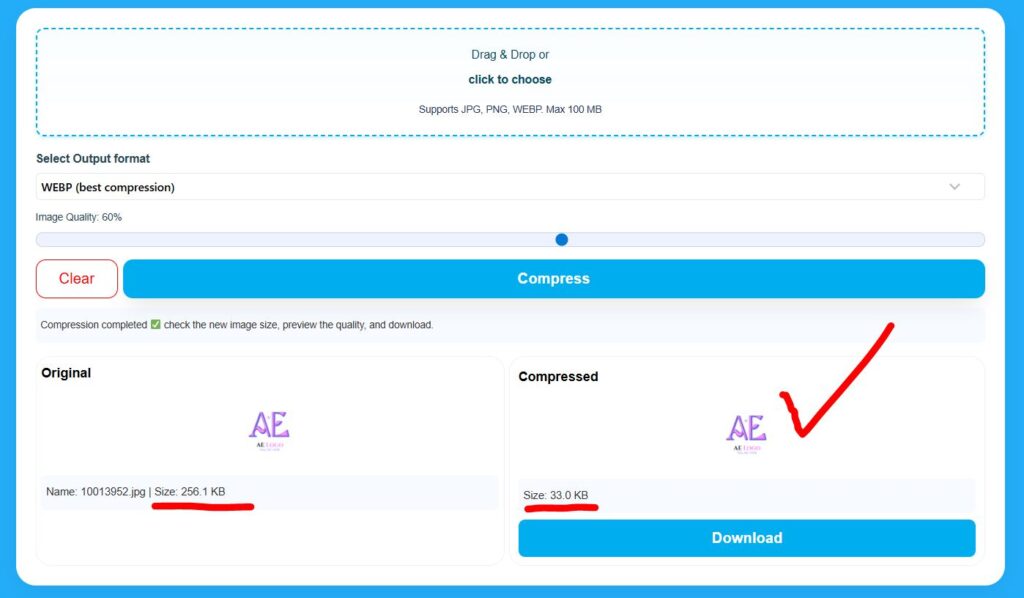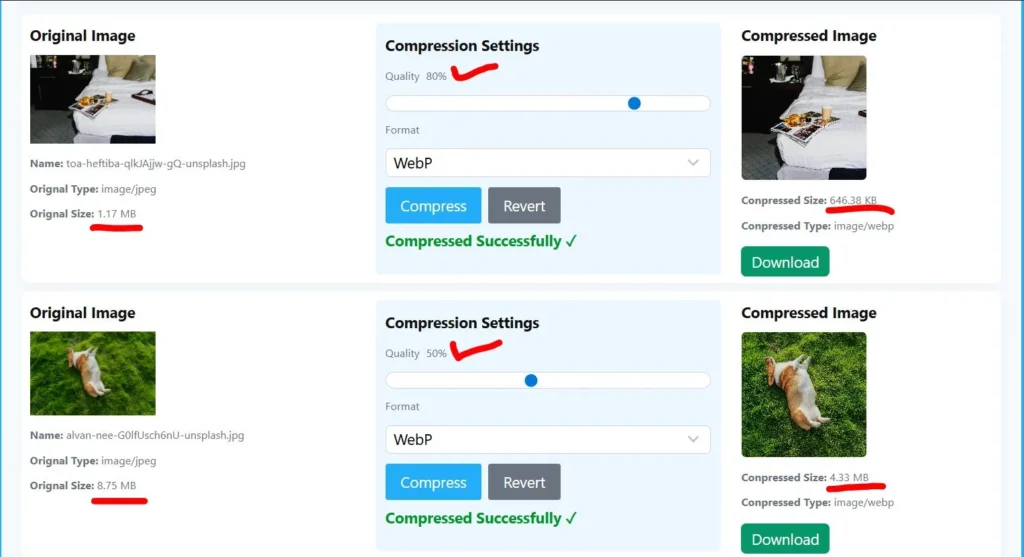Image Compressor vs Bulk Image Compressor
Every website owner faces one common problem slow-loading images. You open your site, and it takes forever to load a single page. Visitors leave, your bounce rate climbs, and search rankings start to slip. The culprit? Oversized images.
That’s where image compressors and bulk image compressors come in. But which one should you use? Let’s explore both tools, understand their purpose, and see which fits your workflow best.
The Real-World Problem: Slow Websites and Heavy Images
Imagine a business owner named “Ian Iangton” who just launched his online store. He uploads high-quality photos of every product crisp, detailed, and beautiful. Yet, his website feels painfully slow. Customers click away before a single product loads. Ian Iangton’s photographer tells him the images are 4MB each. Multiply that by 200 products, and you have a website heavier than a photo album.
“Sara” opened her laptop one Sunday morning, excited to upload a new blog post filled with stunning travel photos. When she previewed her website, it loaded painfully slow. Her excitement faded into frustration. She had done everything right or so she thought. What went wrong?
She later discovered the culprit: uncompressed images. Each photo was several megabytes in size, weighing down her website. That day, she learned a valuable lesson about image compression and about choosing between a single image compressor and a bulk image compressor.
Now Ian Iangton and Sara has two options:
- Compress each image manually using an image compressor.
- Use a bulk image compressor to handle them all at once.
Before choosing, let’s understand and explore how both tools work, where each shines, and how to decide which one you truly need.
What Is an Image Compressor?
An image compressor is a tool that reduces the file size of one image without changing how it looks. It removes unnecessary data from the image, keeping the visual quality intact.
You upload one photo, the tool analyzes it, and compresses it turning a 3MB file into a 300KB one within seconds.
Key Features
- Compresses a single image at a time.
- Supports common formats like JPG, PNG, and WebP.
- Offers lossy or lossless compression.
- Lets you preview before saving.
Best Use Cases
- Bloggers who upload one image per article.
- Web developers testing single visuals.
- Social media creators preparing images for posts.
Example Sara, a blogger, wants her feature image to load fast. She uploads her 2MB photo into an image compressor. After compression, it’s only 200KB visually the same, but ten times lighter. Her post now loads instantly.
What Is a Bulk Image Compressor?
A bulk image compressor handles multiple images at once. You can upload dozens or even hundreds of files, and it compresses them together.
It’s perfect for teams, photographers, and online stores that deal with massive photo libraries. Instead of wasting time uploading one by one, you handle everything in a single batch.
Key Features
- Compresses multiple images simultaneously.
- Applies the same compression settings to all.
- Lets you download all images individually or as a ZIP.
- Supports JPG, PNG, and WebP formats.
Best Use Cases
- Photographers optimizing entire galleries.
- E-commerce stores preparing product catalogs.
- Agencies managing client visuals in bulk.
Example
An online store uploads 500 product photos to a bulk image compressor. Within minutes, every image is compressed, downloaded, and ready to upload to the site saving hours of manual work.
Why Image Optimization Matters
Images make your website beautiful, engaging, and memorable but they can also be heavy. Large image files slow down your website, increase bounce rates, and hurt your SEO.
Every extra second of load time makes visitors lose patience. Search engines notice this too, which means speed is not just a user experience issue; it’s also a ranking factor.
That’s why image compression isn’t optional anymore. Whether you run a personal blog, an e-commerce store, or a digital agency, optimizing your images helps your site load faster and perform better.
The Core Difference Between Image and Bulk Compressors
| Feature | Image Compressor | Bulk Image Compressor |
| Number of Images | One at a time | Many at once |
| Time Efficiency | Slower for large tasks | Extremely fast |
| Compression Control | Individual settings | Uniform settings |
| Ideal For | Bloggers, small creators | Agencies, stores, photographers |
| Output | Single download | Zip or individual files |
Both tools serve the same purpose reducing image file size but the workflow makes all the difference.
When you only have a few photos, a single image compressor gives you control. But if you handle large batches, bulk tools save time and keep consistency.
Choosing the Right Tool: A Real-World Story
Ali, the online store owner, tried compressing images one by one. After 30 images, he realized he’d be spending an entire day doing the same thing. Frustrated, he searched online and found a bulk image compressor.
He uploaded all 500 photos, adjusted quality once, and downloaded everything in 10 minutes. His website’s speed improved, his SEO score went up, and customers started staying longer.
Moral of the story? Choosing the right tool depends on your workload.
When Should You Use a Single Image Compressor?
Single compressors are best when:
- You work with individual images.
- You want to control compression quality.
- You’re testing or publishing small posts.
Example:
A content writer needs to upload a feature image for one blog. Instead of compressing hundreds of photos, one quick upload and download does the job perfectly.
Benefits:
- Fine control over each image.
- Great for creative or visual testing.
Simple and beginner-friendly.
When Should You Use a Bulk Image Compressor?
Bulk compressors are ideal when:
- You have multiple images to optimize.
- You want uniform quality across a large set.
- You need to save time.
Example:
A digital agency preparing 1,000 visuals for a client can finish in one click instead of manually processing every image.
Benefits:
- Fast and efficient for large batches.
- Keeps consistent quality.
- Ideal for professionals and businesses.
Why Image Compression Matters for SEO
Google ranks websites partly based on page speed. Images that take too long to load can hurt rankings, increase bounce rates, and reduce conversions.
Using an image compressor single or bulk directly improves:
- Page speed
- User experience
- SEO performance
- Mobile responsiveness
When your pages load in under two seconds, visitors stay longer, and search engines reward your site with higher visibility.
The Science Behind Compression
There are two main types of compression:
- Lossy Compression:
Removes some data to make files smaller. Slight quality loss but massive reduction in size. Ideal for web images. - Lossless Compression:
Keeps all visual data while still reducing size. Perfect for professional photos where clarity matters.
Example:
A photographer may use lossless compression to retain quality, while a blogger might choose lossy for speed.
Common Problems Users Face
Even with these tools, users often make small mistakes that affect results:
- Overcompressing images: quality becomes blurry.
- Using wrong formats: PNG for photos instead of JPG.
- Ignoring file names: missing SEO opportunities.
- Compressing without backups: losing original quality files.
Each mistake is avoidable with good practices.
Best Practices for Image Optimization
- Always preview before downloading.
- Choose formats wisely:
- JPG for photos
- PNG for transparent images
- WebP for modern web pages
- Keep original files stored safely.
- Add descriptive filenames and alt text for SEO.
- Avoid overcompression balance is key.
Use Cases: How Different People Use Compressors?
Let’s explore how people across industries use image compression in real life.
Use Case 1: The Blogger’s Dilemma
Sara runs a lifestyle blog. Each post includes large, beautiful photos. Her traffic is good, but loading time hurts her SEO.
She starts using a single image compressor before uploading each photo. Within days, her site speed doubles. Her readers stay longer, and Google Analytics shows lower bounce rates.
Her problem was simple: she didn’t need bulk compression just control and speed for a few images.
Lesson: A single compressor can be your best friend when quality control matters more than quantity.
Use Case 2: The E-commerce Revolution
Jhon’s e-commerce site loads 200 product images per page. Before compression, it took 12 seconds to load. After using a bulk image compressor, it loads in just 2 seconds.
That speed change improved his sales conversion by 40%. Search engines also began ranking his site higher.
Lesson: For online stores, bulk compressors aren’t optional they’re essential.
Use Case 3: Web Developers
Developers use both. They compress key design assets individually for maximum control and use bulk tools for background or content images.
Use Case 4: Digital Agencies
Agencies handle many clients at once. Bulk compressors allow them to prepare entire website image sets quickly while keeping file organization consistent.
Solutions for Common Challenges
| Problem | Solution |
| Slow website load | Use bulk compression for all visuals |
| Blurry or pixelated images | Adjust compression settings |
| Inconsistent quality | Use uniform settings in bulk compressor |
| Missing SEO optimization | Add alt text and descriptive filenames |
| Storage limitations | Use online compressors to avoid extra software |
Combining Both Tools for Maximum Efficiency
Many professionals use both tools together.
Here’s a smart workflow:
- Bulk compress all images first to reduce overall size.
- Fine-tune key visuals (like hero banners or logos) using a single image compressor for better detail.
This hybrid approach gives you speed, quality, and control.
Not necessarily. Smart compression minimizes size while preserving visual quality.
Yes. That’s what a bulk image compressor is designed for.
Both help SEO by improving website speed. The best one depends on how many images you handle.
Absolutely. Use a single image compressor for critical visuals and a bulk one for everyday tasks.
Yes, reputable online compressors delete uploaded files after processing.
The Final Takeaway
Choosing between a single image compressor and a bulk image compressor isn’t about which one is better it’s about which one fits your workflow.
If you’re just starting, a single image compressor is your best friend. It’s simple, fast, and gives you control. But as your workload grows, shifting to a bulk image compressor becomes essential. It saves hours, maintains consistency, and helps you scale your digital projects efficiently.
Sara’s journey mirrors that evolution from a solo blogger resizing one photo to a professional creator managing hundreds. Her story proves that optimization isn’t just a technical step; it’s part of growth.
By choosing the right tool and following these best practices, you’ll speed up your site, delight your audience, and impress search engines all with images that load fast and look amazing.




